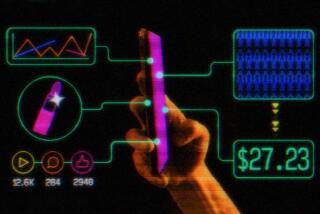Smartphone app can share photos and videos with anyone in the room
Reporting from Palo Alto
Imagine if you could instantly see photos, videos and comments of friends — and strangers — at restaurants, ballparks, concerts or at more intimate gatherings such as birthday parties and weddings.
Color, a Silicon Valley start-up, is about to release a smartphone application that does just that. And, if widely embraced, the free app for iPhones and Android devices could stretch social norms by bringing people together who are in the same physical place, not just hanging out together online.
For the Internet generation already used to carrying smartphones in the palm of their hands to broadcast details of their lives to hundreds of friends or thousands of followers, the Color app is expected to be a hit. That’s why Sequoia Capital, the venture capital firm that backed Google and Apple, and other investors are sinking $41 million into the Palo Alto start-up that created it.
Some in the over-30 crowd may be resistant, however. Despite having gotten comfortable posting photos and updates on Facebook, some are still uneasy with expressing and exposing themselves on Twitter and other more public social networking sites.
But sociologists say it’s an inevitable step in the evolution of the increasingly networked world.
The proliferation of smartphones that lets people stay connected any time and anywhere has given rise to a wave of apps focused on helping people meet others near them, such as Yobongo, an iPhone app that lets you chat with people in the same vicinity. Available in New York, San Francisco and Austin, Texas, it has been downloaded tens of thousands of times in just a few weeks.
It’s a shift from the Internet, which made where you were physically in the world less important, said USC digital sociologist Julie Albright. Smartphones are bringing back that sense of place and face-to-face interaction, she said.
“Apps like this are intended to spawn intimacy between people. It remains to be seen if that experiment works,” Albright said.
Color is one of the first apps to make all photos, videos and comments on a smartphone visible to others in the same location without having to pass around a camera or email or upload images. It uses an algorithm that detects which smartphones loaded with the app are within a 150-foot radius. That radius expands when Color senses clusters of people and phones, say at a music festival or a football game.
The two seasoned entrepreneurs behind Color, Bill Nguyen, the company’s chief executive, and Peter Pham, its president, are convinced that they are onto something — even in Silicon Valley, which is littered with failed ideas and former “it” companies that didn’t live up to their hype. They say they are reinventing the notion of community and infusing a largely faceless, anonymous world with more of a small-town feel.
Nguyen, who describes himself as a recluse, says the service drew him out of his shell. He checks it dozens of times a day to find out what his wife, Amanda, a pastry chef, and his two young boys are doing, as well as to see what’s going on in the lives of his co-workers and friends. He works from a white porcelain bathtub in the window of his company’s headquarters, to the amusement of passersby. And he pads around the office and town in an insulated sleeping-bag suit that make him look like a mash-up between Gumby and the Michelin Man.
Nguyen, who sold his last start-up, music streaming service Lala, to Apple Inc., says Color brings people closer not just to strangers but to those already in their lives.
In demonstrating the app, Nguyen scrolled through thumbnail images of his young son trudging in deep snow on a mountain slope. And with colleague Pham, the former CEO of BillShrink and a top Photobucket executive, sitting nearby, he watched a video of Pham’s young son swinging from a rope in gymnastics class. He noted that two of Color’s 30 employees discovered they had so much in common while browsing each other’s photographs that they started dating.
“Now we have technology that is literally a part of our lives,” Nguyen said. “When you come home from work, your kids don’t have to ask, ‘What did you do at work today?’ When you see your wife, she never has to ask, ‘How was your day?’”
Sociologists say Color — as it becomes available on more devices such as BlackBerry, Windows mobile and the iPad — could get more people in the same place talking to each other rather than relating with friends elsewhere, reviving public interaction in a society where people have become physically dislocated. More than 3 billion photos are uploaded to Facebook each month but are meant not for the people around you but the people you already know.
“In public spaces, we are increasingly heads down in our devices, separated from the people around us,” said Zeynep Tufekci, an assistant professor of sociology at the University of Maryland, Baltimore County, who studies the social effects of technology. “This could be a way to create serendipitous interactions.”
On the flip side, Tufekci fears unintended consequences of pushing people to make too much of their private lives too public, such as a prospective employee revealing more than intended about his or her political or sexual orientation during a job interview. On the fringes lurk other possible pitfalls, such as smartphone snoops stalking strangers.
Nguyen downplays the risks, pointing out that people already expose far more than they realize on social networking sites, where hastily uploaded images can come back to haunt them. Only photos and videos taken with the Color app are shared with surrounding smartphones, and people can be very deliberate about when and how they use it. People can still capture private moments by taking a picture on their iPhone or Android phone just as they always have.
The Color app will be supported by advertising, but the company has plans for ads that it says will be useful, not intrusive and clearly labeled. For example, when you walk into a restaurant that your friends like, you might see images of what they ordered there.
Nguyen says the company plans to maintain a “G-rated” service that allows only content appropriate for all ages. Photos flagged as inappropriate by users will be reviewed, and Color will suspend accounts that violate its policy by blocking the user’s phone.
Online, people can cloak their identity or hide behind their browser, but Pham believes Color users will be self-regulating. “When you are physically near somebody, there is a lot more accountability,” he said.
“Turn on your iPhone, and all of a sudden you can see what’s happening on the other side of the office,” he said. “The world is so much better when it’s open. That’s what Twitter has shown and that’s where we are going to go.”






